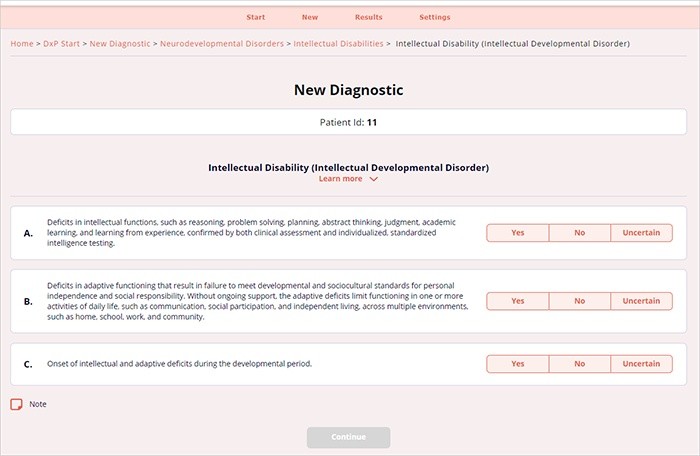|
<< Click to Display Table of Contents >> Diagnostic Criteria |
  
|
|
<< Click to Display Table of Contents >> Diagnostic Criteria |
  
|
The diagnostic criteria are at the center of the diagnostic process and specify the characteristics of the specific diagnosis. The criteria identify symptoms, behaviors, cognitive functions, personality traits, physical signs, syndrome combinations, and durations that require clinical expertise to differentiate from normal life variation and transient responses to stress. A final diagnosis is made on the basis of the clinical interview, diagnostic criteria and descriptions, and clinician judgment.
In the DxP, the diagnostic criteria are programmed as guidelines for making a diagnosis. For each diagnosis, a set of diagnostic criteria indicates symptoms that must be present (and for which duration) as well as a list of other symptoms, disorders, and conditions that must first be evaluated to qualify for a particular diagnosis. While these criteria help increase diagnostic accuracy (i.e., the likelihood that two doctors would come up with the same diagnosis when using DxP to assess a patient), the diagnostic criteria are offered as guidelines for making diagnoses, and their use should be informed by clinical judgment. Ultimately, the most important aspect of the diagnostic process is its clinical utility for the assessment of the clinical course and treatment response of individuals grouped by a given set of diagnostic criteria.
It is important to remember that mental disorders criteria are meant to be used by trained professionals using clinical judgment. They are not meant to be used by the general public. The diagnostic criteria provide a description of how a mental disorder is expressed, and the DxP presents a checklist of the essential characteristics of each mental disorder. The clinician's task in the diagnostic process is to judge the soundness of the criteria’s essential characteristics to the clinical picture presented by the patient. Keep in mind that the symptoms of the diagnostic criteria are a limited collection of human responses to internal and external stresses that are generally maintained in a homeostatic balance without a disruption in normal functioning. It requires clinical training to recognize when the combination of these factors has resulted in a psychopathological dysfunction and mental disorder.
For example, the DxP diagnostic criteria for Intellectual Disability (Intellectual Developmental Disorder) have three criteria, A to C. Each criterion is followed by descriptive text to assist in diagnostic decision-making.

The DxP provides a systematic and dynamic diagnostic process with readily accessible information for each cluster, criteria and specifier, and easy navigation between clusters and diagnoses through the program's breadcrumbs navigation menu. To help with the diagnostic process, on each diagnostic criteria, the DxP provides further details about the criteria’s main features with the "Learn more" toggle. Other important information is included with the Note popups. The Note popups are especially useful as interactive assessment scales for some diagnosis specifiers, like severity and duration.
Navigation menu: ![]()
Learn more: ![]()
Note: ![]()
Following the assessment of diagnostic criteria, when the full criteria are met clinicians should consider the application of the disorder specifiers as appropriate. Severity and course specifiers should be applied to denote the individual's current presentation. When full criteria are not met, clinicians should consider whether the symptom presentation meets the criteria for an Other specified/Unspecified.
The other specified disorder category is provided to allow the clinician to communicate the specific reason that the presentation does not meet the criteria for any specific category within a diagnostic class. This is done by recording the name of the category, followed by the specific reasons why the disorder criteria are not met. For example, for an individual with clinically significant depressive symptoms lasting 4 weeks but whose symptomatology falls short of the diagnostic threshold for a major depressive episode, the clinician would record "other specified depressive disorder, depressive episode with insufficient symptoms." Another example is an emergency department setting, where it may be possible to identify only the most prominent symptom expressions associated with a particular cluster—like, delusions, hallucinations, mania, depression, anxiety, substance intoxication, or neurocognitive symptoms—so that an "unspecified" disorder in that category is identified until a fuller differential diagnosis is possible.
If the clinician chooses not to specify the reason the criteria are not met for a specific disorder, then "unspecified disorder" would be diagnosed. Note that the differentiation between other specified and unspecified disorders is based on the clinician's decision, providing maximum flexibility for diagnosis. Clinicians do not have to differentiate between other specified and unspecified disorders based on some feature of the presentation itself. When the clinician determines that there is evidence to specify the nature of the clinical presentation, the other specified diagnosis can be given. When the clinician is not able to further specify and describe the clinical presentation, the unspecified diagnosis can be given. This is left entirely up to clinical judgment.
In the DxP, if you marked the 'other specified' criteria as Yes, the program opens a free-text popup, for you to specify the reasons why the disorder criteria are not met.
|
Age-related factors specific to diagnosis (e.g., symptom presentation and prevalence differences in certain age groups) are also included in the DxP. Likewise, gender and cultural issues have been integrated into the diagnostic process, and in the results where applicable. Further information about gender, culture, and age factors is provided in the diagnosis analytic report.